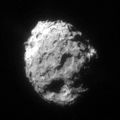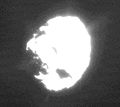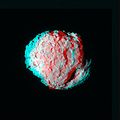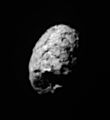- 81P/Wild
-
81P/Wild 
Comet Wild 2 (81P/Wild) nucleus in 2004Discovery Discovered by: Paul Wild Discovery date: 1978 Alternate designations: 1978 XI; 1984 XIV;
1990 XXVIIIOrbital characteristics A Epoch: March 6, 2006 Aphelion distance: 5.308 AU Perihelion distance: 1.592 AU Semi-major axis: 3.45 AU Eccentricity: 0.5384 Orbital period: 6.408 a Inclination: 3.2394° Last perihelion: February 22, 2010[1] Next perihelion: July 20, 2016[2][3] Comet 81P/Wild, also known as Wild 2 (
 /ˈvɪlt/ vilt), is a comet named after Swiss astronomer Paul Wild, who discovered it in 1978 using a 40-cm Schmidt telescope at Zimmerwald.[4]
/ˈvɪlt/ vilt), is a comet named after Swiss astronomer Paul Wild, who discovered it in 1978 using a 40-cm Schmidt telescope at Zimmerwald.[4]For most of its 4.5 billion-year lifetime, Wild 2 probably had a more distant and circular orbit. In September 1974, it passed within one million kilometers of the planet Jupiter, whose strong gravitational pull perturbed the comet's orbit and brought it into the inner Solar System.[5] Its orbital period changed from 43 years to about 6 years,[5] and its perihelion is now about 1.59 AU (astronomical unit).[6]
Contents
Nucleus parameters
Stardust mission
NASA's Stardust Mission launched a spacecraft, named Stardust, on February 7, 1999. It flew by Wild 2 on January 2, 2004, and collected particle samples from the comet's coma, which were returned to Earth along with interstellar dust it collected during the journey. 72 close-up shots were taken of Wild 2 by Stardust. They revealed a surface riddled with flat-bottomed depressions, with sheer walls and other features that range from very small to up to 2 kilometres across. These features are believed to be caused by impact craters or gas vents. During Stardust's flyby, at least 10 gas vents were active. The comet itself has a diameter of 5 kilometres.
Stardust's "sample return canister," was reported to be in excellent condition when it landed in Utah, on January 15, 2006. A NASA team analyzed the particle capture cells and removed individual grains of comet and interstellar dust, then sent them to about 150 scientists around the globe.[10] NASA is collaborating with The Planetary Society who will run a project called "Stardust@Home", using volunteers to help locate particles on the Stardust Interstellar Dust Collector (SIDC).
As of 2006,[11] the composition of the dust has contained a wide range of organic compounds, including two that contain biologically usable nitrogen. Indigenous aliphatic hydrocarbons were found with longer chain lengths than those observed in the diffuse interstellar medium. No hydrous silicates or carbonate minerals were detected, which suggests a lack of aqueous processing of Wild 2 dust. Very few pure carbon (CHON) particles were found in the samples returned. A substantial amount of crystalline silicates such as olivine, anorthite and diopside were found,[12] materials only formed at high temperature. This is consistent with previous observations of crystalline silicates both in cometary tails and in circumstellar disks at large distances from the star. Possible explanations for this high temperature material at large distances from Sun were summarised before the Stardust sample return mission by van Boekel et al.:[13]
- Both in the Solar System and in circumstellar disks crystalline silicates are found at large distances from the star. The origin of these silicates is a matter of debate. Although in the hot inner-disk regions crystalline silicates can be produced by means of gas-phase condensation or thermal annealing, the typical grain temperatures in the outer-disk (2−20 au) regions are far below the glass temperature of silicates of approx 1,000 K. The crystals in these regions may have been transported outward through the disk or in an outward-flowing wind [14]. An alternative source of crystalline silicates in the outer disk regions is in situ annealing, for example by shocks or lightning. A third way to produce crystalline silicates is the collisional destruction of large parent bodies in which secondary processing has taken place. We can use the mineralogy of the dust to derive information about the nature of the primary and/or secondary processes the small-grain population has undergone.
Results from a study reported in the September 19, 2008 issue of the journal Science has revealed an oxygen isotope signature in the dust that suggests an unexpected mingling of rocky material between the center and edges of the solar system. Despite the comet’s birth in the icy reaches of outer space beyond Pluto, tiny crystals collected from its halo appear to have been forged in the hotter interior, much closer to the Sun.[15]
In April 2011, scientists from the University of Arizona discovered evidence for the presence of liquid water. They have found iron and copper sulfide minerals that must have formed in the presence of water. The discovery shatters the existing paradigm that comets never get warm enough to melt their icy bulk.[16]
Gallery
See also
Wild 2 shares a similar name with the other objects:
References
- ^ Kinoshita, Kazuo (April 13, 2005). "81P past, present and future orbital elements". Comet Orbit. FC2. http://jcometobs.web.fc2.com/pcmtn/0081p.htm.
- ^ Nakano, Syuichi (2009-12-12). "81P/Wild 2 (NK 1861)". OAA Computing and Minor Planet Sections. http://www.oaa.gr.jp/~oaacs/nk/nk1861.htm. Retrieved 2010-02-24.
- ^ Yeomans, Donald K.; Chamberlin, Alan B.. "Horizons Ephemeris". JPL Solar System Dynamics. http://ssd.jpl.nasa.gov/horizons.cgi?find_body=1&body_group=sb&sstr=81P. Retrieved 2011-02-22.
- ^ Wild, P. (1978). Marsden, B. G.. ed. "Comet Wild (1978b)". IAU Circular 3166 (1): 1. Bibcode 1978IAUC.3166....1W.
- ^ a b Kronk, Gary W. (2001–2005). "81P/Wild 2". Cometography.com. http://cometography.com/pcomets/081p.html. Retrieved 2008-10-23. (Cometography Home Page)
- ^ "81P/Wild - Orbital Elements". IAU Minor Planet Center, Harvard University. http://scully.cfa.harvard.edu/cgi-bin/returnprepeph.cgi?d=c&o=0081P. Retrieved 2011-05-26.
- ^ "Comet 81P/Wild 2". The Planetary Society. http://www.planetary.org/explore/topics/asteroids_and_comets/wild2.html. Retrieved 2008-12-16.
- ^ Britt, D. T.; Consol-magno SJ, G. J.; Merline, W. J. (2006). "Small Body Density and Porosity: New Data, New Insights" (PDF). Lunar and Planetary Science XXXVII. http://www.lpi.usra.edu/meetings/lpsc2006/pdf/2214.pdf. Retrieved 2008-12-16.
- ^ Using the volume of an ellipsoid of 5.5×4.0×3.3 km * a rubble pile density of 0.6 g/cm³ yields a mass (m=d*v) of 2.28×1013 kg
- ^ Jeffs, William (January 18, 2006). "Scientists Confirm Comet Samples, Briefing Set Thursday". NASA. http://www.nasa.gov/mission_pages/stardust/news/J06-005.html. Retrieved 2008-03-05.
- ^ McKeegan, K. D.; et al.. "Light element isotopic compositions of cometary matter returned by the STARDUST mission". Lawrence Livermore National Laboratory. https://e-reports-ext.llnl.gov/pdf/339631.pdf. Retrieved 2008-03-05.
- ^ Stricherz, Vince (March 13, 2006). "Comet from coldest spot in solar system has material from hottest places". University of Washington. http://www.uwnews.org/article.asp?articleID=23093. Retrieved 2008-03-05.
- ^ van Boekel, R.; et al. (2004). "The building blocks of planets within the 'terrestrial' region of protoplanetary disks". Nature (ukads.nottingham.ac.uk) 432 (7016): 479–482. Bibcode 2004Natur.432..479V. doi:10.1038/nature03088. PMID 15565147.
- ^ Liffman, K., Brown, M. (1995). "The motion and size sorting of particles ejected from a protostellar accretion disk". Icarus (www.elsevier.com/) 116: 275–290. Bibcode 1995Icar..116..275L. doi:10.1006/icar.1995.1126.
- ^ University of Wisconsin-Madison (September 15, 2008). "Comet Dust Reveals Unexpected Mixing of Solar System". Newswise. http://newswise.com/articles/view/544352/. Retrieved 2008-09-18.
- ^ LeBlanc, Cecile (2011-04-07). "Evidence for liquid water on the surface of Comet Wild-2". http://earthsky.org/space/evidence-for-liquid-water-on-the-surface-of-comet-wild-2. Retrieved 2011-04-07.
External links
- NASA/JPL homepage for Stardust project
- Stardust@Home Volunteer Particle Analysis Project
- Catalogue of all 72 raw images of Wild 2
Periodic comets (by number) Previous
80P/Peters-Hartley81P/Wild Next
82P/GehrelsCategories:- Comets
- Comets visited by spacecraft
- Stardust (spacecraft)
Wikimedia Foundation. 2010.






